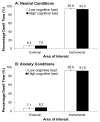Research Article
- PMID: 33831135
- PMCID: PMC7141087
- DOI: 10.16910/jemr.10.5.8
Research Article
Abstract
In this study, we demonstrate the effects of anxiety and cognitive load on eye movement planning in an instrument flight task adhering to a single-sensor-single-indicator data visualisation design philosophy. The task was performed in neutral and anxiety conditions, while a low or high cognitive load, auditory n-back task was also performed. Cognitive load led to a reduction in the number of transitions between instruments, and impaired task performance. Changes in self-reported anxiety between the neutral and anxiety conditions positively correlated with changes in the randomness of eye movements between instruments, but only when cognitive load was high. Taken together, the results suggest that both cognitive load and anxiety impact gaze behavior, and that these effects should be explored when designing data visualization displays.
Keywords: anxiety; attention; cognitive load; entropy; eye tracking; heart rate; instruments.
Conflict of interest statement
The author(s) declare(s) that the contents of the article are in agreement with the ethics described in http://biblio.unibe.ch/portale/elibrary/BOP/jemr/ethics.html and that there is no conflict of interest regarding the publication of this paper.
Figures






References
-
- Allsop J., Gray R., Bulthoff H. H., & Chuang L. (2016). Effects of anxiety and cognitive load on instru-ment scanning behavior in a flight simulation. In 2016 IEEE Second Workshop on Eye Tracking and Visualiza-tion (ETVIS) (pp. 55–59). https://doi.org/10.1109/ETVIS.2016.7851167 - DOI
LinkOut - more resources
Full Text Sources
